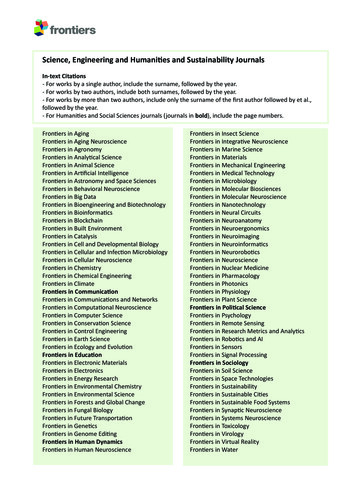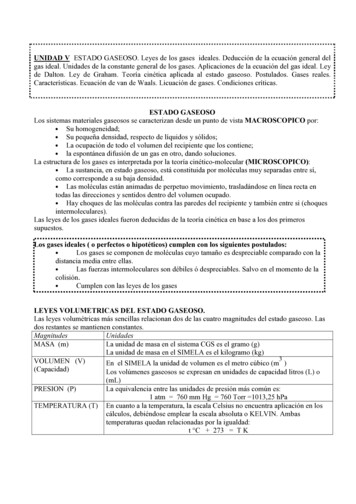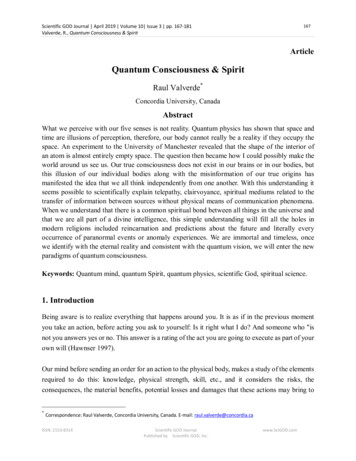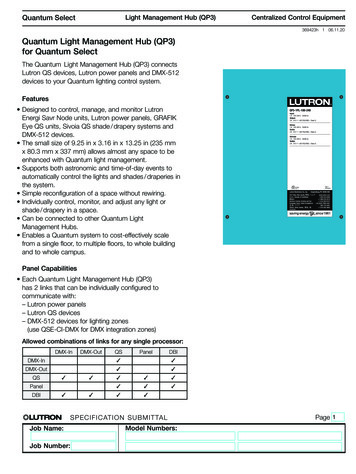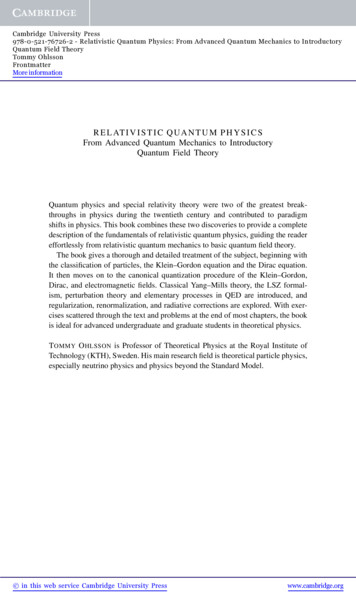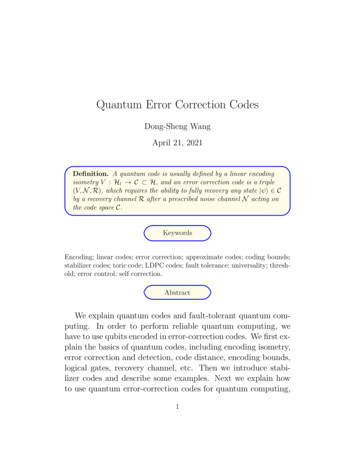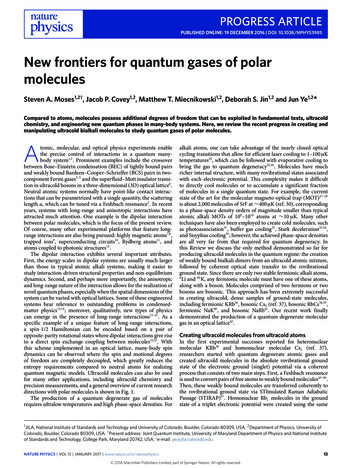
Transcription
PROGRESS ARTICLEPUBLISHED ONLINE: 19 DECEMBER 2016 DOI: 10.1038/NPHYS3985New frontiers for quantum gases of polarmoleculesSteven A. Moses1,2†, Jacob P. Covey1,2, Matthew T. Miecnikowski1,2, Deborah S. Jin1,2 and Jun Ye1,2*Compared to atoms, molecules possess additional degrees of freedom that can be exploited in fundamental tests, ultracoldchemistry, and engineering new quantum phases in many-body systems. Here, we review the recent progress in creating andmanipulating ultracold bialkali molecules to study quantum gases of polar molecules.Atomic, molecular, and optical physics experiments enablethe precise control of interactions in a quantum manybody system1,2 . Prominent examples include the crossoverbetween Bose–Einstein condensation (BEC) of tightly bound pairsand weakly bound Bardeen–Cooper–Schrieffer (BCS) pairs in twocomponent Fermi gases3–5 and the superfluid–Mott insulator transition in ultracold bosons in a three-dimensional (3D) optical lattice6 .Neutral atomic systems normally have point-like contact interactions that can be parametrized with a single quantity, the scatteringlength a, which can be tuned via a Feshbach resonance2 . In recentyears, systems with long-range and anisotropic interactions haveattracted much attention. One example is the dipolar interactionbetween polar molecules, which is the focus of the present review.Of course, many other experimental platforms that feature longrange interactions are also being pursued: highly magnetic atoms7,8 ,trapped ions9 , superconducting circuits10 , Rydberg atoms11 , andatoms coupled to photonic structures12 .The dipolar interaction exhibits several important attributes.First, the energy scales in dipolar systems are usually much largerthan those in typical atomic alkali systems, making it easier tostudy interaction-driven structural properties and non-equilibriumdynamics. Second, and perhaps more importantly, the anisotropicand long-range nature of the interaction allows for the realization ofnovel quantum phases, especially when the spatial dimensions of thesystem can be varied with optical lattices. Some of these engineeredsystems bear relevance to outstanding problems in condensedmatter physics13,14 ; moreover, qualitatively, new types of physicscan emerge in the presence of long-range interactions15–21 . As aspecific example of a unique feature of long-range interactions,a spin-1/2 Hamiltonian can be encoded based on a pair ofopposite-parity rotational states where dipolar interactions give riseto a direct spin exchange coupling between molecules22,23 . Withthis scheme implemented in an optical lattice, many-body spindynamics can be observed where the spin and motional degreesof freedom are completely decoupled, which greatly reduces theentropy requirements compared to neutral atoms for realizingquantum magnetic models. Ultracold molecules can also be usedfor many other applications, including ultracold chemistry andprecision measurements, and a general overview of current researchdirections with polar molecules is shown in Fig. 1.The production of a quantum degenerate gas of moleculesrequires ultralow temperatures and high phase-space densities. Foralkali atoms, one can take advantage of the nearly closed opticalcycling transitions that allow for efficient laser cooling to 1–100 µKtemperatures24 , which can be followed with evaporative cooling tobring the gas to quantum degeneracy25,26 . Molecules have muchricher internal structure, with many rovibrational states associatedwith each electronic potential. This complexity makes it difficultto directly cool molecules or to accumulate a significant fractionof molecules in a single quantum state. For example, the currentstate of the art for the molecular magneto-optical trap (MOT)27–29is about 2,000 molecules of SrF at 400 µK (ref. 30), correspondingto a phase-space density orders of magnitude smaller than typicalatomic alkali MOTs of 109 –1010 atoms at 10 µK. Many othertechniques have also been employed to create cold molecules, suchas photoassociation31 , buffer gas cooling32 , Stark deceleration33,34 ,and Sisyphus cooling35 ; however, the achieved phase-space densitiesare all very far from that required for quantum degeneracy. Inthis Review we discuss the only method demonstrated so far forproducing ultracold molecules in the quantum regime: the creationof weakly bound bialkali dimers from an ultracold atomic mixture,followed by coherent optical state transfer to the rovibrationalground state. Since there are only two stable fermionic alkali atoms,6Li and 40 K, any fermionic molecule must have one of these atoms,along with a boson. Molecules comprised of two fermions or twobosons are bosonic. This approach has been extremely successfulin creating ultracold, dense samples of ground-state molecules,including fermionic KRb36 , bosonic Cs2 (ref. 37), bosonic RbCs38,39 ,fermionic NaK40 , and bosonic NaRb41 . Our recent work finallydemonstrated the production of a quantum degenerate moleculargas in an optical lattice42 .Creating ultracold molecules from ultracold atomsIn the first experimental successes reported for heteronuclearmolecular KRb36 and homonuclear molecular Cs2 (ref. 37),researchers started with quantum degenerate atomic gases andcreated ultracold molecules in the absolute rovibrational groundstate of the electronic ground (singlet) potential via a coherentprocess that consists of two main steps. First, a Feshbach resonanceis used to convert pairs of free atoms to weakly bound molecules43–46 .Then, these weakly bound molecules are transferred coherently tothe rovibrational ground state via STImulated Raman AdiabaticPassage (STIRAP)47 . Homonuclear Rb2 molecules in the groundstate of a triplet electronic potential were created using the same1JILA, National Institute of Standards and Technology and University of Colorado, Boulder, Colorado 80309, USA. 2 Department of Physics, University ofColorado, Boulder, Colorado 80309, USA. † Present address: Joint Quantum Institute, University of Maryland Department of Physics and National Instituteof Standards and Technology, College Park, Maryland 20742, USA. *e-mail: ye@jila.colorado.eduNATURE PHYSICS VOL 13 JANUARY 2017 www.nature.com/naturephysics ƐƎƏƖɥMacmillan Publishers LimitedƦɥ/ 13ɥ. ɥ /1(-%#1ɥ 341#. All rights reservedƥ13
NATURE PHYSICS DOI: 10.1038/NPHYS3985PROGRESS ARTICLEabUltracold chemistry Quantum many-body ––––––––––––Precision measurements1.25 e1〉 d VibrationΩ4 〉 1, 0〉 Δ 1, 1〉 1, 1〉 2B 0, 0〉Eeff Ω 2 Ω3Ω1SElectronic e2〉 〉Tilt (θ 0 in rad)cx1.05FCI(CSL)0.850.65SSS0.45Superfluid(XY ferromagnet)0.250.05Striped solid(SDW)0Elab4KMS(SDW)CKB(SDW)8 12 16 20 24 28 32 36 40 44d.c. electric field (kV cm 1)–Figure 1 A survey of the applications of ultracold molecules. a, Working with ultracold molecules gives experimenters the ability to precisely control theinitial states of a chemical reaction, determine the rovibrational states of the products, and use external electric and magnetic fields to control reactionrates and pathways. b, Polar molecules are ideal candidates for realizing novel quantum many-body systems and for encoding quantum information(in rotational or hyperfine states, for example)102 . The figure illustrates a proposal to realize a fractional Chern insulator with a 2D array of polar molecules.SDW, spin density wave; FCI, fractional Chern insulator; CSL, chiral spin liquid; KMS, knight’s move solid; SSS, striped supersolid; CKB, checkerboard.c, Because of their many degrees of freedom, polar molecules can be used for a variety of precision measurement applications103 , including tests for parityand charge–parity violation104 and tests for time variation of fundamental constants such as the fine structure constant (for which electronic transitions aremore sensitive)105 and the electron-to-proton mass ratio49 (for which vibrational transitions are more sensitive). Polar molecules are especially favourablefor electron electric dipole moment searches because a small electric field in the lab produces a huge effective electric field in the molecule106–108 . Panel breproduced from ref. 20, APS.protocol48 . In certain molecules, such as Sr2 , very favourableFranck–Condon factors allow for efficient photoassociation into adeeply bound state49,50 or for direct STIRAP from two atoms onindividual sites of a 3D lattice51 .In the simplest case, STIRAP involves two lasers: one couples theFeshbach molecule state f i to an excited state ei (which is usuallylossy), and another couples ei to a deeply bound state g i. Thescheme may be more complicated, as in Cs2 , where there are actuallyfive states involved, and either two stages of STIRAP or a fourphoton scheme are required37 . The state ei is chosen to optimize theFranck–Condon factors with both f i and g i. The Franck–Condonoverlap between a weakly bound Feshbach molecular state andselected excited molecular states is much higher than for free atoms.For the two-photon transition to have a reasonable strength, theexcited molecular state must also have an admixture of singlet andtriplet characters (since g i is a singlet while f i is a triplet). Bialkalistypically have spin–orbit coupling in excited electronic states thatgives rise to singlet–triplet mixing. Figure 2a displays the relevantenergy levels for KRb. The overall structure is very similar for otherbialkali molecules.STIRAP transfers the entire population from f i to g i withoutpopulating the lossy state ei, provided that the two laser fieldsare phase coherent throughout the transfer process. The timedependence of the laser intensities (Fig. 2b) is chosen to maintaina coherent dark state that adiabatically evolves from the initialto the final state. Photons carry away the binding energy, andthe coherent process does not produce any heating. For typicalexperimental parameters, a relative laser linewidth less than 1 kHzis required for efficient transfer, which can readily be achieved bystabilizing lasers to an optical frequency comb36,52 or a high-finesse14optical cavity53,54 . Magnetic field noise must also be minimized, sinceFeshbach molecules usually have an appreciable magnetic dipolemoment (NaRb is a notable exception41 ), while singlet ground-statemolecules have a negligible magnetic dipole moment.Manipulating rotational and hyperfine statesThe ground state of bialkalis is an electronic singlet, but hyperfinestructure is inherited from the nuclear spins of the constituentatoms. Angular momentum selection rules allow STIRAP to beconfigured to populate only one of these hyperfine states, thuscreating a spin-polarized sample. This is accomplished by preciselycontrolling the frequency and polarization of the Raman lasers.Although the molecule has a body-fixed dipole moment µ, therovibrational ground state is an eigenstate of parity, and thus hasno space-fixed dipole moment d in the absence of an external field.A d.c. electric field can be applied to mix opposite-parity rotationalstates and induce a dipole moment d in the lab frame (the rotationalstates are labelled by N , mN i, where N is the principal rotationalquantum number and mN is its projection on the quantizationaxis). Experimentally, one can measure d by performing Starkspectroscopy (Fig. 2c), which simply measures the energy shift of g iin an electric field. The electric field magnitude needed to saturatethe dipole moment depends on the critical field Ec (Ec B/µ, whereB is the rotational constant). For example, to reach d 0.8µ for theN 0 state, a field of about 10Ec is required.Another way to generate strong dipolar interactions in the labframe is to directly couple two opposite-parity rotational states usinga.c. electric fields55 . By coupling the N 0 and N 1 states withmicrowaves, one introduces dipolar interactions arising from anoscillating dipole moment of µ/ 3. Figure 2d shows a simplifiedNATURE PHYSICS VOL 13 JANUARY 2017 www.nature.com/naturephysics ƐƎƏƖɥMacmillan Publishers LimitedƦɥ/ 13ɥ. ɥ /1(-%#1ɥ 341#. All rights reservedƥ
NATURE PHYSICS DOI: 10.1038/NPHYS3985Power (mW)8Ω 1 (970 nm)6 i〉 Feshbach moleculesΩ 2 (690 nm)04S 5Sa3Σ–1d0.50.020151050DumpPump010–4530 40 50 60STIRAP time t (μs)E70 20 30 40 50 60 7010000400800Field (V cm 1)0.60.40.20.0008001,600Field (V cm 1)200400600Electric field (V cm 1)800N 1 1, mI〉X1Σσ πσ 1015Internuclear separation (a0)ΔmI 120 0, mI〉N 01.0f7.50501001502000.50.01.00100200300400α /h (10 5 MHz W 1 cm2)1.0 0, mI〉 N 0 0, mI 1〉8.00.50.0σ π g〉 (v 0)Fraction 10 0, mI 1〉 δ 1, mI〉N 1 0, mI〉e802000E 1, mI〉–2–320Excitedstateshift (MHz) e〉 (v′ 23)1.010Dipole moment (D)23Σ4S 5PGround state shift (MHz)11π10Energy (103 cm–1)cb12NF (103)aPROGRESS ARTICLE6.56.04.54.0200Time (μs)300400 1, 1〉5.00.0100 0, 0〉5.50.50 1, 1〉7.0 1, 0〉015304560Angle ( )7590Figure 2 Creating and manipulating ultracold bialkali molecules. a, The energy levels of KRb molecules. STIRAP couples the Feshbach state with theground state via an electronic excited state (see text). b, The upper panel plots the number of Feshbach molecules versus time during the STIRAPsequence, while the bottom panel plots the laser intensities. The ground-state molecules are dark to the Feshbach molecule detection. c, Stark shift of RbCsground-state molecules, from which a dipole moment of 1.23 D is inferred. The inset shows the Stark shift of the excited state. d, The lowest-energyrotational states of KRb. To couple hyperfine states in the N 0 manifold, a two-photon Raman transition via the N 1 state is used. e, Rabi oscillationsbetween rotational states in KRb. In the top panel, the hyperfine state is unchanged, while in the middle and bottom panels, mRb and mK are changed,respectively. f, The real part of the polarizability of KRb molecules at 1,064 nm versus the angle between a linearly polarized lattice beam and thequantization axis. When the polarizabilities of two states are equal, a ‘magic’ condition leads to an enhanced coherence time for rotational superpositions.Reproduced from ref. 36, AAAS (a); ref. 38, APS (b); ref. 39, APS (c); ref. 55, APS (d,e); and ref. 60, APS (f).schematic of the rotational states of KRb. Each rotational state N , mN i has 36 hyperfine states (since IK 4 and IRb 3/2). Thesestates can be labelled by additional quantum numbers for the nuclearspin of K and Rb, mK and mRb , respectively. A coupling betweenrotation and the nuclear electric quadrupole moment mixes thesestates, so mK , mRb and mN are not individually conserved; however, their sum mF mK mRb mN is conserved56 . The strongestrotational transitions from the 0, 0i state are those that preservemK and mRb . To change the hyperfine state in the ground rovibrational state, one can take advantage of the aforementioned coupling in the N 1 manifold to perform a two-photon transition,where two hyperfine states in the N 0 manifold are coupledthrough a common state in the N 1 manifold55,57,58 . We notethat direct magnetic dipole transitions between hyperfine states inthe ground state are very weak. Sample data for such two-photontransitions are shown in Fig. 2e. These two-photon transitions havemany applications: they can be used to transfer the molecules tothe absolute lowest energy hyperfine state in cases where STIRAPdoes not initially populate the lowest energy state55 , or they canbe used to prepare long-lived coherent superpositions of twohyperfine states59 .When working with molecules confined in an optical trap, animportant issue for preserving coherence of the N 0 and N 1superposition is to match the a.c. polarizability of the two rotationalstates at the optical trapping wavelength60 . The motivation for doingso is the same as operating an optical lattice clock at the ‘magic wavelength’61 . This can be achieved by some combination of electric andmagnetic fields, as well as by the orientation of the light polarizationwith respect to the quantization axis62 . In ref. 60, the real part ofthe polarizability of the N 0 and N 1 states was measured as afunction of the angle between the polarization vector of a verticallyoriented lattice and a magnetic field (Fig. 2f), in the absence of ad.c. electric field. This led to the determination of the ‘magic angle’,which is especially pronounced for the 0, 0i 1, 0i transition. Atthe ‘magic angle’, the coherence time of rotational superpositions ismaximized. However, due to hyperpolarizability (the dependence ofNATURE PHYSICS VOL 13 JANUARY 2017 www.nature.com/naturephysics ƐƎƏƖɥMacmillan Publishers LimitedƦɥ/ 13ɥ. ɥ /1(-%#1ɥ 341#. All rights reservedƥ15
NATURE PHYSICS DOI: 10.1038/NPHYS3985PROGRESS ARTICLEbcE 4, 1/2〉 4, 3/2〉50/50 mixtureQTMQDT151050.20.40.60.81.00.0012 3 4E (kV cm 1)5iiiJJ0.1Dipole moment, d (D)5NaRb number (a.u.)iiGround-state NaRb number (103)fi0.10.01Temperature (μK)e1010d1000.2100β /T0 (10 5 cm3 s 1 K 1)Decay coeff. β (10 12 cm3 s 1)200d (D)a4321.00.50.0 0.2 0.10.00.10.2Dump detuning (MHz)10050100150Hold time (ms)200250Figure 3 Controlling chemical reactions with optical lattices. a, At zero electric field, the p-wave centrifugal barrier for spin-polarized fermionic KRbmolecules is isotropic (top), while in an applied d.c. field, the barrier is reduced for attractive ‘head-to-tail’ collisions and increased for repulsive‘side-by-side’ collisions (bottom). b, Temperature dependence of the chemical reaction rate at zero electric field. For spin-polarized samples, the two-bodydecay rate β T, as expected from the Wigner threshold laws. For a spin mixture, the decay rate is much higher and independent of temperature. c, Scaledchemical reaction rate for a spin-polarized sample versus induced dipole moment d scales as d6 . The inset shows d versus applied electric field. d, Byconfining chemically reactive molecules in optical lattices, the reactions can be suppressed in a 1D lattice (upper picture)66 or effectively shut off in a 3Dlattice (lower picture)67 . e, The chemical reactivity in the lattice depends highly on the molecules’ quantum statistics and band distribution. (i) Pauliblocking prevents indistinguishable molecules in the lowest band from occupying the same lattice site, suppressing chemical reactions. (ii)Indistinguishable molecules in different bands can chemically react in the ‘head-to-tail’ orientation66 . Molecules could be in higher bands because ofheating or high initial temperature. (iii) Distinguishable molecules can occupy the same lattice site and chemically react with no centrifugal energy barrier.However, if the chemical reaction rate 0 is much larger than the tunnelling rate J, the quantum Zeno effect suppresses the chemical reactions72 . f, Even formolecules that are chemically stable to two-body chemical reactions, such as NaRb, there is another predicted loss mechanism due to ‘sticky’ collisions(see text). Here, the loss of spin-polarized NaRb molecules in the absolute ground state is plotted, along with a fit assuming two-body loss. Reproducedfrom ref. 65, NPG (a,c); ref. 64, AAAS (b); and ref. 41, APS (f).the polarizability on intensity), the coherence time was limited bythe variation in light intensity across the molecular cloud.Controlling chemical reactionsFor many applications based on ultracold molecules, it is mandatoryfor the system to be stable and long-lived. In spin-polarized atomicsystems, the dominant loss mechanism is three-body recombination, where two atoms collide to form a weakly bound moleculeand the third atom simultaneously carries away the binding energy, leading to the loss of all three. With polar molecules, twobody chemical reactions can lead to loss; for example, the reaction2AB A2 B2 can be exothermic. A simple model that describesthese chemical reactions is based on multichannel quantum-defecttheory (MQDT)63 , and assumes that once two molecules get tosufficiently short range, they react with high probability. In the limitthat this probability is unity, the chemical reactions are universaland can be described with knowledge of only the long-range partof the potential. For spin-polarized fermions, the lowest energycollision channel is p-wave, giving rise to a centrifugal energy barrierthat suppresses the rate at which molecules come to short range(Fig. 3a), while bosons (or distinguishable particles) can collide via16s-wave interactions, leading to much higher reaction rates than forp-wave collisions.Fermionic KRb molecules were found to undergo exothermicchemical reactions at ultralow temperatures64,65 . These chemicalreactions can be described with simple quantum collision processesinvolving a few partial waves (Fig. 3b,c). The anisotropy of thedipole–dipole interactions plays a crucial role. In an applied electricfield, molecules colliding in the ‘head-to-tail’ orientation have alower p-wave barrier than molecules colliding in the repulsive‘side-by-side’ orientation. Thus, ‘head-to-tail’ collisions are thedominant loss channel, and can be suppressed by placing themolecules in a 1D lattice to create effective 2D optical traps witha d.c. electric field applied perpendicularly to the plane66 , or shutoff completely by confining the molecules in individual zerodimensional sites of a 3D lattice67 (Fig. 3d). In a 1D lattice, boththe quantum statistics and lattice band distribution of the moleculesplay an important role (Fig. 3e). Because of finite temperature andfinite harmonic confinement, the experiments of ref. 66 were notperformed in a fully 2D trap, and thus the inelastic loss rate wassuppressed only by about a factor of 60. For very strong opticalconfinements and sufficiently large electric fields, repulsive dipolarNATURE PHYSICS VOL 13 JANUARY 2017 www.nature.com/naturephysics ƐƎƏƖɥMacmillan Publishers LimitedƦɥ/ 13ɥ. ɥ /1(-%#1ɥ 341#. All rights reservedƥ
NATURE PHYSICS DOI: 10.1038/NPHYS3985J bπ/2ŷπŷT/2π/2n̂T/2ẑx̂100π2πPhase (rad)0.80.50.000202N 0.79(7) 104N 2.0(2) 104Contrast1.01.0ContrastNumber (104)n̂21.0ŷ0.5440 60T (ms)800.0010203040T (ms)c80Coherence time (ms)aPROGRESS ARTICLE604020005101520Number (103)25ed40 μm440.6330.4220.211040 μm040 μm0.0Figure 4 Recent experiments with polar molecules in optical lattices. a, Schematic of spin exchange. b, Experimentally, a spin-echo Ramsey experimentwas used to observe spin exchange. The contrast decays in a density-dependent way (the coherence time τ 1/N) and oscillates roughly independently ofdensity. These experiments were performed at very low filling fractions, or densities. c, The scheme employed in ref. 42 to increase the molecule fillingfraction was to first optimize the density and spatial overlap of the K (blue) and Rb (red) quantum gases. Lattice sites with one K and one Rb are efficientlyconverted to molecules67,83 . d, Typical in situ absorption images of K (left), Rb (middle), and ground-state molecules (right). The Rb cloud is significantlysmaller than the K cloud to have a density of one atom per site in the centre of the lattice. The optimized ground-state molecule filling is more than 25%.e, A quantum gas microscope for molecules would allow for single-site spin-sensitive detection and manipulation (top). The science cell of thesecond-generation KRb experiment at JILA (bottom) features improved imaging resolution and better electric field control via indium-tin-oxide (ITO)coated plates and tungsten rods in vacuum, and is compatible with a high numerical aperture objective for quantum gas microscopy. Reproduced fromref. 71, NPG (a,b); and ref. 42, AAAS (c). Adapted from ref. 42, AAAS (d).interactions can suppress inelastic collisions, regardless of thequantum statistics68,69 .In a 3D lattice, if s-wave inelastic collisions are allowed, the onsite loss rate 0 for two molecules is very large. 0 can be significantlylarger than the tunnelling rate J and be of the same order of magnitude as the energy gap between the two lowest lattice bands. Inthis regime, molecular tunnelling onto a lattice site that is alreadyoccupied by other molecules is suppressed by the quantum Zenoeffect, and, counterintuitively, the effective loss rate of the wholesystem scales as J 2 / 0, decreasing as the on-site loss rate increases(see Fig. 3e, iii). This continuous quantum Zeno suppression was observed first in homonuclear Rb2 Feshbach molecules70 , and more recently with an incoherent mixture of two rotational states in KRb71,72 .For molecules that are chemically stable with respect to two-bodyloss, another proposed loss mechanism is three-body loss via ‘sticky’collisions73,74 , where two molecules first collide to form a reactioncomplex. While they are close to each other, a third molecule approaches and forces the complex to a more deeply bound molecularstate, leading to inelastic loss of all three molecules. Preliminaryexperiments with RbCs38 and NaRb41 suggest this may actually occur(Fig. 3f), although more work is needed to confirm this.Quantum magnetism with polar moleculesTurning off the chemical reactions in KRb in the 3D lattice madeit possible to observe the long-range nature of the dipole–dipoleinteraction between molecules pinned in a deep optical lattice wheretunnelling, and thus both elastic and inelastic contact interactions,are absent. Polar molecules can be used to study quantummagnetism where an interacting spin-1/2 Hamiltonian can beconstructed based on the use of two opposite-parity rotationalstates75,76 . Specifically, the experiments of refs 71,77 used thefollowing mapping: i 0, 0i and i 1, 1i or i 1, 0i.The molecules undergo spin-exchange interactions, depictedschematically in Fig. 4a, and described by a long-range XY model:H 1X2Vdd (ri rj )i6 j J Ŝ Ŝi Ŝj Ŝ i j2(1)where Vdd (ri rj ) ((1 3 cos2 θij )/ ri rj 3 ), ri is the position ofmolecule i in units of the lattice spacing, θij is the angle betweenri rj and the quantization axis, and Sˆ and Sˆ are spin-1/2 raising2and lowering operators. The coupling constant J (d /a3lat ),where d is the transition dipole moment between the tworotational states (equal to µ/ 3 at zero electric field) and alat isthe lattice constant.In an applied d.c. field, there is also an IsingPinteraction i,j Jz Sˆzi Sˆzj . Additionally, there are other terms omittedfrom equation (1) that can convert between rotational and orbitalangular momentum, which can give rise to a novel form of spin–orbit coupling21 .NATURE PHYSICS VOL 13 JANUARY 2017 www.nature.com/naturephysics ƐƎƏƖɥMacmillan Publishers LimitedƦɥ/ 13ɥ. ɥ /1(-%#1ɥ 341#. All rights reservedƥ17
NATURE PHYSICS DOI: 10.1038/NPHYS3985PROGRESS ARTICLEIn refs 71,77, the spin dynamics were probed with Ramseyspectroscopy to measure the time evolution of the spin coherence(Fig. 4b). A spin echo was required to mitigate the effects of rapidsingle-particle dephasing resulting from residual differential a.c.Stark shifts60 . The contrast decay was observed to have a dependenceon both the molecular density and on the choice of excited state (J is a factor of two larger for i 1, 0i compared to i 1, 1i).Theoretical modelling based on a cluster expansion showed that interactions beyond nearest and next-nearest neighbour are necessaryto explain the experimental data, and estimated the lattice fillingsto be 5–10% (ref. 77). At higher lattice fillings, and with improvedimaging resolution, such a system shows great potential as a quantum simulator that could address questions in quantum many-bodydynamics that are computationally intractable. We note that similarexperiments have been performed in magnetic Cr atoms78 .Creating a dense molecular gas in a 3D latticeThe difficulty of cooling chemically reactive molecules in bulk,combined with the stability afforded by the 3D lattice67 , suggestsan alternative way to create a low-entropy gas of polar molecules:to load atom gases into the lattice to optimize the distribution ofeach atomic species and then make molecules at individual latticesites79,80 . In the case of a Bose–Fermi mixture, the ideal distributionsare a Mott insulator (MI) for the bosons6 and a spin-polarized bandinsulator for the fermions81 , with precisely one atom of each speciesper site in the centre of the lattice42 . This parallels earlier work withhomonuclear Rb2 and Cs2 molecules, where molecules were createdfrom a MI in a 3D lattice37,82 , optimized to have two atoms per site inthe centre. In these experiments, the density overlap was very simplesince only a single atomic species was involved. However, in theBose–Fermi case, the situation is very different, as the two specieshave vastly different requirements to have one particle per site: hightrap frequencies (large compression) and large atom numbers for thefermions, but low trap frequencies and small atom numbers for thebosons. In the Bose–Bose case, the challenge is to spatially overlaptwo single-atom MIs.Refs 42,83 systematically studied this quantum synthesis approach for the 40 K87 Rb Bose–Fermi mixture (Fig. 4c,d). The first stepinvolved determining the filling of the atomic gases by themselves,and indeed it was found that a small Rb quantum gas (with lessthan 5,000 atoms) and a large K degenerate gas (with more than105 atoms) were required to achieve fillings approaching 1 persite at the centre. The next step was to ensure an optimal spatialoverlap between these two low-entropy atomic distributions and toguard against any negative impact of the presence of one species onthe other. To preserve the filling of the Rb MI in the presence ofsuch a large K cloud, it was imperative to turn off the interspeciesinteractions by loading the lattice at aK Rb 0. In the limit of smallRb atom numbers, magnetoassociation converted more than 50%of the Rb to Feshbach molecules. Converting Feshbach moleculesinto ground-state molecules, fillings 25% in a 3D lattice wereachieved, significantly higher than previous results on ground
state of the art for the molecular magneto-optical trap (MOT)27 29 isabout2,000moleculesofSrFat 400 K(ref.30),corresponding to a phase-space density orders of magnitude smaller than typical atomic alkali MOTs of 109 1010 atoms at 10 K. Many other techniques have also been employed to create cold molecules, such

